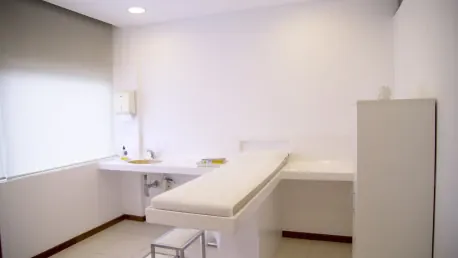Clinical trials are essential for advancing medical research and developing new treatments. However, one of the significant challenges faced by clinical trials is patient enrollment. According to GlobalData, over half of clinical trial failures are due to enrollment problems. Patients often feel overwhelmed by the process, and logistical barriers further amplify this intimidation. While many variables in clinical trials are uncontrollable, one element within reach is the design of clinical trial spaces. Traditionally, these spaces have been process-centered, emphasizing efficiency and clinical needs over patient comfort. This has resulted in cold, sterile environments that can exacerbate feelings of anxiety and uncertainty among patients. Transforming these spaces into more welcoming and comfortable environments could play a crucial role in improving patient experiences and, consequently, enrollment rates. As more healthcare providers and researchers begin to recognize this, a shift towards patient-centered design is emerging in the industry.
Redefining Clinical Trial Spaces
The concept of designing clinical trial spaces with the “science of hope” is a revolutionary approach. Hope is a critical element in clinical settings, as it often signifies the first moment patients can envision a positive outcome, especially when previous treatments have failed. Psychologist Charles R. Snyder’s hope theory from the 1990s posits that hope is a goal-oriented mindset combining the motivation to pursue objectives with pathways to achieve them. Research has shown that hope enhances resilience, health outcomes, and human progress. By grounding clinical trial spaces in the science of hope, the aim is to create an environment where patients can tangibly feel and experience hope, both physically and emotionally. This paradigm shift challenges traditional design norms and introduces a more holistic approach to patient care within clinical trials.
Interestingly, the idea is to move away from the typical sterile and intimidating clinical environments to ones that offer comfort and tranquility, thus enhancing the overall well-being of patients. By incorporating elements that promote positivity, such as natural lighting, comfortable seating, and aesthetically pleasing decor, patients can feel more at ease during their visits. This innovative approach not only nurtures a sense of hope but also encourages patients to maintain a positive outlook throughout their treatment journey. The underlying principle is that a hopeful and relaxed state of mind can significantly contribute to healing and resilience, making the patient-centered design a vital aspect of modern clinical trial spaces.
Design Principles: Comfort, Connection, and Familiarity
Cancer treatment centers have been ahead of the curve in creating warm, welcoming environments. These centers often feature comfortable chairs, soothing views, and engaging activities such as video games, board games, puzzles, and quiet spaces for work or decompression. The goal is to adopt similar principles to foster resilience and well-being. Every detail in the redesigned trial spaces is meticulously considered to support healing and provide a sense of comfort and possibility. By focusing on these elements, the design aims to alleviate some of the emotional strain that patients may experience, fostering a more supportive and encouraging atmosphere.
A significant shift from traditional clinical trial designs involves focusing on patient needs and comfort rather than merely clinical functions. The central area of the facility resembles a home’s living room and kitchen—places where people naturally gather and feel at ease. This communal area invites patients and families to relax, socialize, or share a meal. Patients complete a survey before arriving to share their likes, dislikes, and dietary restrictions, often specific to certain metabolic diseases. This personalized approach helps to stock the kitchen with comfort foods and snacks tailored to their preferences, creating a welcoming atmosphere from the start. By creating an environment that mirrors the comforts of home, these spaces help mitigate the stress and apprehension often associated with clinical trial visits.
Entertainment and Engagement
The living area is equipped with streaming services and a game pass, offering access to popular programming and games to entertain and distract patients during long visits. TVs provide options for all ages, ensuring that patients and their families remain entertained and comfortable. For parents who need to work, the facility includes ample outlets for charging devices, thus enabling them to maintain productivity while accompanying their loved ones. The inclusion of such amenities demonstrates a thoughtful approach to addressing the varied needs of patients and their families, making the clinical trial experience more manageable and less daunting.
For pediatric patients, the design includes age-appropriate zones with puzzles, games, and tactile art positioned at a child’s eye level. For neurodivergent children, quiet rooms serve as soothing spaces for decompression without sensory overload. These rooms are thoughtfully designed for different age groups, with soft, sturdy furniture and calming features for toddlers, and private, comfortable furniture for teens. This attention to detail ensures that children of all ages and needs are catered to, providing them with a comforting and engaging environment that supports their emotional and physical well-being. By addressing the unique requirements of pediatric patients, the design reinforces the commitment to creating inclusive and supportive trial spaces for every participant.
Rethinking Regulatory Requirements
One of the surprising findings in the process was the flexibility in meeting regulatory standards. Contrary to the assumption that regulations necessitate traditional, sterile designs, there is ample room for creativity in building patient-centered spaces. Advances in healthcare-compliant fabrics allow the incorporation of soft and homey materials. Fun, playful wallpaper adds a light touch, making the space feel less clinical. This revelation underscores the importance of re-evaluating preconceived notions about regulatory constraints and embracing innovative design solutions that prioritize patient comfort and emotional well-being.
The authors intentionally avoided typical doctor’s office elements like examination tables and old-style cabinets and sinks. Instead, they prioritized layouts and furnishings that felt familiar and welcoming, aligning with the patient-centered care vision. By challenging conventional design norms and exploring new possibilities, they were able to create spaces that not only meet regulatory requirements but also enhance the overall patient experience. This approach demonstrates that it is possible to maintain compliance while simultaneously prioritizing the human aspects of healthcare, fostering a more holistic and nurturing environment for patients.
Positive Impact and Industry Implications
The potential impact of this new design approach could extend beyond the organization, offering a model for others in the industry to follow. Initial feedback from patients and their families has been overwhelmingly positive, with many noticing and appreciating the thoughtful details. Early reactions from pharmaceutical industry partners have been encouraging, highlighting a growing recognition of the importance of patient comfort and emotional resilience in clinical settings. This promising response indicates that the adoption of patient-centered design principles could become more widespread, potentially transforming the landscape of clinical trial spaces across the industry.
By designing spaces that prioritize both clinical efficiency and patient well-being, the aim is to inspire others to rethink clinical environments. Embracing principles grounded in the science of hope and patient-centered care, the vision is to set a new standard in the field, encouraging a shift towards spaces designed to make patients feel at ease and hopeful, even during the most challenging times. This forward-thinking approach has the potential to redefine patient experiences, improve enrollment rates, and ultimately facilitate the progress of medical research and treatment development.









